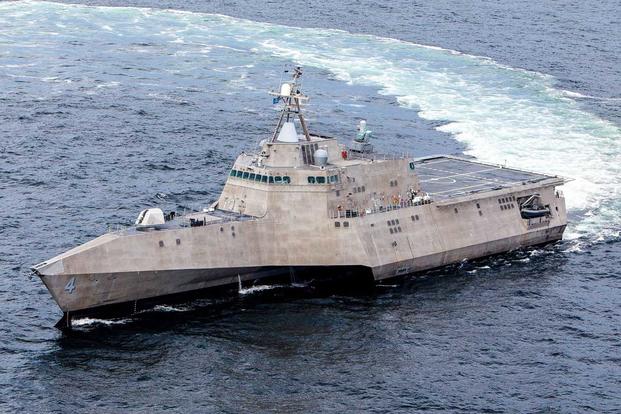It's official: The U.S. Navy plans to reduce its Littoral Combat Ship buy from 52 to 40 vessels over the next five years, according to the service's fiscal 2017 budget request released on Tuesday.
With a base budget request of $155.4 billion, the Navy's spending plan for the fiscal year beginning Oct. 1 is about $4 billion less than it was for fiscal 2016, though some of that will be offset by a $9.5 billion request in overseas contingency operations funding.
The Navy is also set to lose 4,400 active-duty sailors, nearly all enlisted, as it approaches a long-term steady state that will have 50,000 sailors underway on ships year-round. This end strength reduction, from 327,300 sailors to 322,900 sailors, represents the most significant reduction in forces since fiscal 2012. Current projections show the service maintaining its end strength after this year with small adjustments, with a projected active-duty force of 323,100 by fiscal 2021.
"Over the next five years the Navy will continue to make adjustments to properly size manpower accounts to reflect force structure decisions, reduce manning gaps at sea, and improve fleet readiness," the service budget request states.
In a briefing to reporters at the Pentagon, Deputy Assistant Secretary of the Navy for Budget Rear Adm. William Lescher said the drawdown would take place through natural attrition, primarily as the service deactivates its 10th Carrier Air Wing in the coming fiscal year.
This deactivation, he said, will also allow the Navy to match its air wings up with its deployable aircraft carriers, and shore up readiness through the reallocation of aircraft to remaining wings.
This strategy has its critics, though. In one of a series of statements Tuesday criticizing the Navy’s budget request, Rep. Randy Forbes, R-Va., chairman of the House Armed Services seapower and projection forces subcommittee, called the deactivation of a carrier air wing a "dangerous" move.
"This administration is committed to the reduction of our naval forces. Two years ago, they proposed to eliminate an aircraft carrier. This year, they want to eliminate an aircraft carrier wing. I think this is a dangerous trajectory," Forbes said. "My subcommittee added almost $1 billion to ensure we retain our aircraft carrier force structure and have added over $2 billion to support additional strike fighters over the last two years. I opposed the elimination of the aircraft carrier and will seek to oppose any ill advised reductions in our aircraft carrier wing."
The Navy's budget outlook has been a subject of much speculation since December, when Defense Secretary Ashton Carter sent a memo ordering the service to decrease its long-term LCS and frigate buy by 12 ships, down-select to one variant and builder, and reinvest some of the savings in aircraft and other weapons systems. The service's budget request keeps to that plan, with funding to purchase two LCS in fiscal 2017 and one each until 2020.
In a brief to reporters, Deputy Secretary of Defense Bob Work said the decision to buy fewer LCS/frigates emphasized the Defense Department’s focus on "shape, rather than size."
"This is not an indictment against the LCS. If we didn’t like the ship, we would stop buying it," he said. "But those 12 ships would take us from 321 to 309 ships, and it allowed us to put more money into torpedoes, more money into P-8 [Poseidons], more money into advanced munitions, more money into tactical aviation. So it was more about achieving that balance between size, readiness and modernization …we made a decision to go for capability."
The Navy now plans to purchase 30 P-8 Poseidon aircraft between now and 2021, 11 of which will be procured in FY 2017.
Lescher said savings from the LCS down-select would also fund long-term investments in procurement of certain weapons systems. The Navy will purchase 10 long-range anti-ship missiles [LRASM] in FY 2017, for example, and 25 each in FY 18 and 19, equipping aircraft including the F/A-18 Super Hornet and F-35C Joint Strike Fighter with cutting edge munitions. The FY 17 request includes the purchase of 100 Tactical Tomahawk missiles, a move Lescher said was also tied to ship-buy savings. Procurement is also up for the SM-6 ship-launched missile in the next five years, from 113 missiles in FY 16 to 125 per year from FY 17 to FY 21.
Other key investment areas include the F-35C Joint Strike Fighter, with proposed funding to procure four in the coming fiscal year; the Virginia-class submarine, with two planned for purchase; and the LHA (R) America-class amphibious assault ship. The budget would fund the purchase of LHA-8, the yet-to-be-named third America-class ship, at a cost of $1.6 billion.
The Navy is also moving into the procurement phase of the Ohio replacement program, with funding to replace the existing class of Ohio-class fleet ballistic missile submarines. The budget contains $773 million for advance procurement of long-lead items, plus more than $1 billion in continued research, development and design.
The purchase of two additional Arleigh-Burke class destroyers will mean a total procurement of seven new ships in the next fiscal year. Overall, the Navy is set to have 308 ships by 2021, up from 280 at the end of 2016, according to budget documents.
The biggest year-over-year budget reductions for the Navy will come in aircraft procurement, where the service is set to spend about $14.1 billion -- more than $3.5 billion less than the previous year.
The budget line for research, development, testing and evaluation is also down about $835 million from the current year. This year's request also zeroes out the National Defense Sealift Fund, a decades-old spending account used to purchase unarmed Navy vessels. That account contained $474 million last year.
The budget would support initiatives laid out in Chief of Naval Operations Adm. John Richardson's campaign design for the fleet. The proposals were released last month. It also reaffirms plans to invest in innovation through new uses of simulators, gaming and other technologies to enhance training and support "high-velocity learning."
It would also fund Navy cyber capabilities, including development of control point defense capabilities for aviation control systems and investment in better fleet cyber situational awareness, according to budget documents.
In a statement released Tuesday, Richardson voiced cautious approval for the budget request.
"Today's budget environment is forcing tough choices but must also inspire new thinking as we seek to achieve balance," he said. "The margins of victory are razor thin, and only the team that fights for every inch wins. Our budget request supports this urgent business."
-- Hope Hodge Seck can be reached at hope.seck@military.com. Follow her on Twitter at @HopeSeck.
Related Video:



























